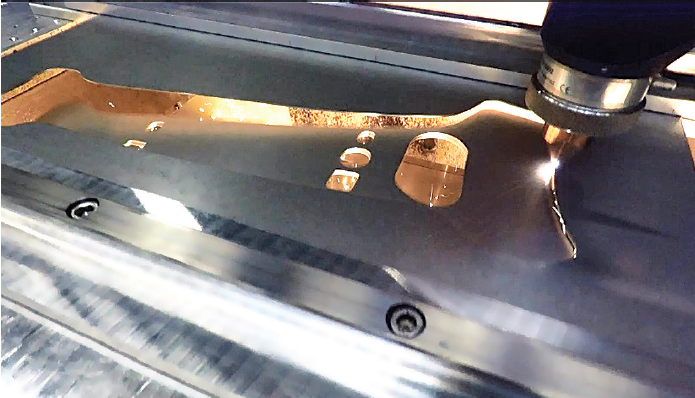
A multifunctional laser processing head plays a major role in the new NRW project MultiPROmobil; it enables innovative sheet metal assemblies through the integrated cutting, welding and manufacture of structures additively. © Fraunhofer ILT, Aachen, Germany.
The Fraunhofer Institute for Laser Technology ILT from Aachen presents five groundbreaking developments on all major trends in contemporary sheet metal processing – from hybrid lightweight construction to multifunctional laser robots with an integrated digital twin.
There is a common denominator for all five processes: They stand for different approaches to agile, laser-based manufacturing, and balance flexibility and productivity. Such manufacturing processes are particularly in demand for hybrid lightweight construction and electromobility, two major trends in sheet metal working. “Laser technology combined with digitalisation is a predestined solution for economically producing constantly fluctuating and unpredictable lot sizes in volatile markets“, explains Dr. Dirk Petring, group leader for Macro Joining and Cutting at Fraunhofer ILT.
Clever interplay of robot and laser processing head
The lighthouse project MultiPROmobil fits in with this need: The NRW-funded project is a robot and a multifunctional laser processing head designed to enable clever interaction and integrate cutting, welding and generating of structures additively. They are to be supported by a digital twin as well as intelligent design and simulation software. With MultiPROmobil, the Fraunhofer experts and their industrial partners want to reduce commissioning time by 30% and unit costs and resource consumption by at least 20%
“In a subsequent expansion phase, a production facility with several robots were built, in which each individual robot masters all three production disciplines“, says Dr. Petring, looking into the future. “In this way, process chains for the production of sheet metal assemblies can be made very flexible and scalable, especially with regard to the gradual introduction of e-mobility“.Currently, the project participants are working on further developing the combi-head so that it can be changed between cutting, welding and now additive manufacturing processes as needed and without changing the optics and nozzles.
Laser beam high-speed cutting supersedes punching process
Another highlight of the Aachen scientists at EuroBLECH is the flexible high-speed cutting of metal strips: With assistance from Fraunhofer ILT, Honda has replaced the previous punching process – of sheet metal of up to 1.8m by 4m and a thickness of 0.5 to 2.3mm – by an extremely fast laser cutting process, with a speed of up to 11 m/min at its plant in Yorii, Japan. Honda has achieved an output of 18,700 car body parts per day since introducing the laser blanking system in 2015.

Instead of punching: Together with BILSTEIN GmbH & Co. KG, Fraunhofer ILT has developed a very fast cutting process for differentiated rolled strip with partially different properties. © Fraunhofer ILT, Aachen, Germany.
Dr. Petring says, “At the fair in Hanover, reported on the next step towards a very fast cutting process for differentiated rolled strips with partially different properties; we are currently developing this process together with BILSTEIN GmbH & Co. KG in Hagen, Germany. Decisive arguments for BILTSTEIN are the tool-free production of variable cutting contours and maximum material savings in the manufacturing process as well as in terms of the subsequent component weight. Not only did we show a video about the process, but also first shaped blanks made using our process“.
Joining ultra high-strength steels reliably
The lightweight construction trend towards ultra highstrength steels is the focus of a project funded by the German Federation of Industrial Research Associations (AiF), which is supported by FOSTA (Forschungsvereinigung Stahlanwendung e.V.): Within the scope of FAAM (short for Further development, joining technology validation and technical design of welded joints with martensitic chromium steels), Fraunhofer ILT and its partners are developing and testing laser welding processes on various components. The demonstrator, for example, is a laser-designed bumper module, which the Aachen scientists demonstrated how different high- and ultra-high-strength materials can be laserwelded in a hybrid construction.
Freeform mirror creates suitable laser beam
The optimal spatial and temporal adjustment of the temperature field plays the main role in the current research in the field of laser heat treatment. In Hanover, Fraunhofer ILT showed how, by adapting the beam profile with the aid of a freeform mirror, areas and zones can be selectively and locally processed in order to generate defined strength profiles. In order to make laser heat treatment reliable and cost-effective with short cycle times, the Aachen scientists are working with significantly higher feed rates.
Process time and costs for raw materials lowered
The fifth exhibit, a roof bow created as part of the BMBF project HyBriLight, received the “Future of Composites in Transportation 2018 Innovation Award“in Chicago in June 2018 at a JEC event. An original part of a vehicle from the BMW 7 Series was used as a model: a hybrid component with a fiber-reinforced plastic cross member (previously pure CFRP) and metallic connecting elements to the car body. As an alternative to bonding and riveting previously used, the Aachen scientists use a laser-based joining process that connects plastic and metal with positive locking and adhesion.
Moreover, material costs were significantly reduced by using GFRP instead of the more expensive CFRP. The latter is now used only as a strength-enhancing insert on the long sides of the cross member. The roof bow is finally trimmed with an innovative laser cutting process, which allows processing of the material sandwich made of GFRP and CFRP in a single step. Several advantages speak in favour of innovation:reduction of process times by 70 percent compared to conventional processes, halving of raw material costs and the integration of several process steps into one process.
“In Hanover, we showed the new roof bow version, whose material mix of GFRP, CFRP and metal demonstrates the versatility of laser processing for joining and cutting complex components“, reports Dr. Frank Schneider, senior project manager in the group of Macro Joining and Cutting at Fraunhofer ILT.

 iConnectHub
iConnectHub
 Login/Register
Login/Register Supplier Login
Supplier Login


























